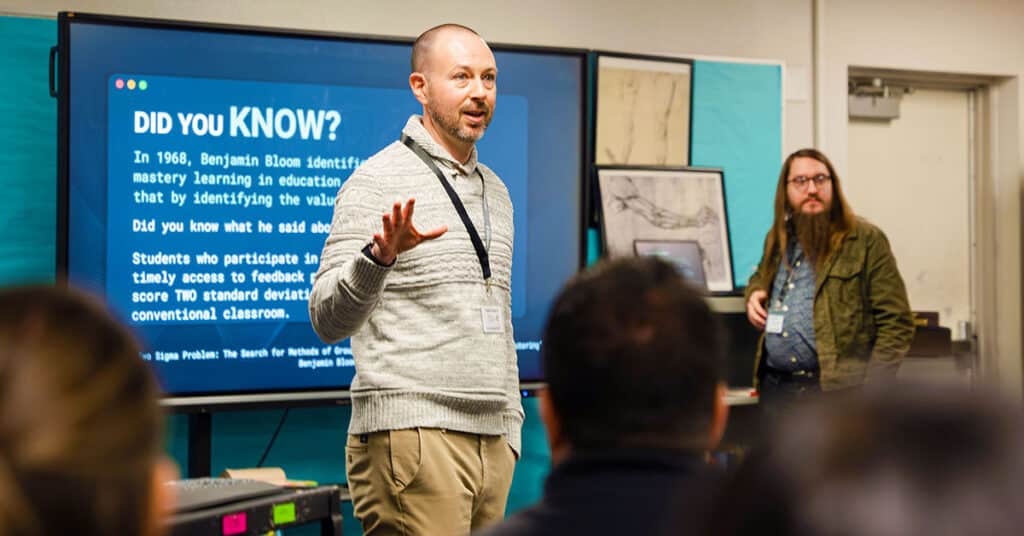Nearly six years into its personalized, competency-based learning implementation journey, Yuma Union High School District is a case study in how to leverage technology, relationships and messaging to build a culture of transparency and trust.

Transparency is critical for systems change, and communication plays a crucial role. By adopting inclusive communication practices, learning communities can facilitate shared decision-making, uphold accountability and make processes visible and accessible. Transparency not only builds trust but empowers all members to actively contribute. Here are few tips for getting started:
1. Use technology to enhance two-way communication
Platforms should be user-friendly and accessible, allowing stakeholders to easily access information, participate in discussions and stay connected with the district’s activities and updates. Mobile apps and web-based platforms like Canvas, Parent Square and TalkingPoints allow teachers to communicate with parents through public posts or private text messages, ensuring that important information reaches parents quickly and reliably. The seamless sharing of classroom updates, student progress and even photos and videos fosters a collaborative environment between school and home.
Jason Flora, an educator with the Yuma Union High School District (YUHSD) shares his experience. “I really like being able to send text messages to parents whether it is through TalkingPoints or ParentSquare because it meets the parents where they are,” he said. “It helps both of us support the learners in getting the best education possible.”
2. Remember the importance of human connection
Though technology has revolutionized the way we communicate, providing numerous benefits and efficiencies, human connection and relationships are still of utmost importance. As we embrace technological tools, we must remain intentional about creating spaces for open dialogue and feedback. Actively listening to feedback and being responsive to concerns and suggestions, builds trust and strengthens relationships. In person engagements might include regular town hall meetings, community gatherings and focus groups.
“Transparency, communication and engagement are the cornerstones of successful education systems transformation,” said Robin Kanaan, KnowledgeWorks teaching and learning senior director. “When a school district prioritizes these values, it ensures that every member of the learning community is informed and involved in shaping a shared vision of the future.”
At YUHSD, the district engaged the community in developing its Profile of the Graduate, with more than 330 focus group participants actively contributing to the process. The district also hosts monthly campus tours, led by the superintendent and staff, which are open to the public to foster direct interaction. “Parent Academy” sessions are held regularly to help parents and families deepen their understanding of personalized, competency-based learning, ensuring they are equipped to support their learners with a focus on the future.
“The purpose of Parent Academy is to equip families with valuable insights and resources to navigate the waters of high school and help pave the way to success in college, career and community upon graduation,” YUHSD Director of Strategic Planning Mike Sharp said.
In this video clip, Courtney Davis, director of curriculum with Tallmadge City Schools, and Dr. Amy Brennan, deputy superintendent with Mason City Schools, share their experiences and strategies for establishing a common language and integrating it into their Ohio districts’ cultures.
3. Establish clear and consistent messaging
Consistent messaging is vital for building trust and credibility within a learning community. Districts should develop a communications plan that outlines key messages, goals and the channels that can be used to disseminate messages to various audiences. Regular updates, newsletters and transparent sharing of information help keep everyone informed and engaged.
During the first year of personalized, competency-based learning implementation at YUHSD, the focus was on developing internal capacity – ensuring that the governing board, district leaders, campus administration, educators and support personnel understood the goals and the mindset shifts that were needed to achieve desired outcomes.
Throughout that first year, weekly communications were shared, including videos, articles, resources and testimonials from early adopters, to gradually build understanding and common language. During board engagements and professional learning sessions, learner-centered strategies were modeled, reinforcing the district’s commitment to this approach to teaching and learning.
“During the early phases of implementing personalized, competency-based learning, knowing that we had a shared understanding of the goals made a huge difference. We received regular updates and resources that kept us informed. And we were given autonomy on how to implement this transformation,” Sharp adds.



